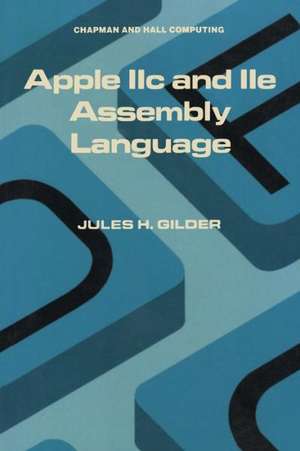Apple IIc and IIe Assembly Language
Autor Jules H. Gilderen Limba Engleză Paperback – 7 aug 1986
Preț: 640.35 lei
Preț vechi: 800.45 lei
-20% Nou
Puncte Express: 961
Preț estimativ în valută:
122.59€ • 127.91$ • 102.76£
122.59€ • 127.91$ • 102.76£
Carte tipărită la comandă
Livrare economică 13-27 martie
Preluare comenzi: 021 569.72.76
Specificații
ISBN-13: 9780412011214
ISBN-10: 0412011212
Pagini: 178
Ilustrații: X, 178 p.
Dimensiuni: 155 x 235 x 10 mm
Greutate: 0.28 kg
Editura: Springer Us
Colecția Springer
Locul publicării:New York, NY, United States
ISBN-10: 0412011212
Pagini: 178
Ilustrații: X, 178 p.
Dimensiuni: 155 x 235 x 10 mm
Greutate: 0.28 kg
Editura: Springer Us
Colecția Springer
Locul publicării:New York, NY, United States
Public țintă
ResearchCuprins
1 Machine Code or Assembly Language.- (Why machine code?).- 2 Numbers.- (Binary, hex and decimal, Binary to decimal conversion, Decimal to binary conversion, Binary to hex conversion, Hex to decimal conversion).- 3 It All Adds Up!.- (Binary arithmetic, Addition, Subtraction, Binary coded decimal (BCD), BCD addition, BCD subtraction).- 4 It’s Logical.- (Logical operations, AND, OR, EOR).- 5 The Registers.- (The accumulator, The index registers, The program counter).- 6 A Poke at Machine Code.- (Code —the program counter, Entering machine code, The hex loader program, Calling machine code, Saving it out to disk, The Apple ROMs.- 7 Status Symbols.- (The status register).- 8 Addressing Modes I.- (Zero page addressing, Immediate addressing).- 9 Bits and Bytes.- (Load, store and transfer, Paging memory).- 10 Arithmetic in Assembler.- (Addition, Subtraction, Negation, Using BCD).- 11 Addressing Modes II.- (Absolute addressing, Zero page indexed addressing, Absolute indexed addressing, Indirect addressing, Post-indexed indirect addressing, Pre-indexed absolute addressing, Implied and relative addressing).- 12 Stacks of Fun.- (The stack, Stack instructions for saving data).- 13 Looping.- (Loops, Counters, Comparisons, Branches, FOR ... NEXT, Memory counters).- 14 Subroutines and Jumps.- (Subroutines, Passing parameters, Jumps).- 15 Shifts and Rotates.- (Arithmetic shift left, Logical shift right, Rotate left, Rotate right, Logically speaking, Printing binary!, BIT).- 16 Multiplication and Division.- (Multiplication, Division).- 17 Assembly Types.- (Conditional assembly, Look-up tables).- 18 Floating a Point.- (The floating point accumulators, Using USR, Integer to floating point, Floating point to integer, Floating memory, The subroutines).- 19 Speeding Up and Slowing Down.-20 Interrupts and Breaks.- (Interrupts, Breaks).- 21 Prepacked Utilities.- (Hex to binary conversion, Binary to hex conversion, Output ASCII string).- Appendices.- 1 The Screen.- 2 The 6502 and 65C02.- 3 The Instruction Set.- 4 Instruction Cycle Times.- 5 Apple // Memory Map.- 6 Branch Calculators.- 7 6502 and 65C02 Opcodes.- General Index.- Program Index.



